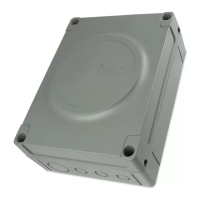10 – ENGLISH
4. verify that, when intervening on the devices connected to
the inputs, the corresponding LEDs switch off or on
5. verify that, when pressing the “[Stop/Set]” button and
[Close
q
] (“Figure 18”) for over 3 seconds, both the mo-
tors complete a brief opening manoeuvre with the upper
leaf motor starting rst. Stop the manoeuvre by pressing
the [Stop/Set] button. LED “L9” (“Figure 17”) must switch
on to signal the correct self-recognition.
18
l
If the motors do not start for the opening manoeu-
vre, invert the polarity of the motor cables. If the
rst motor to move is not the one associated with
the upper leaf, invert M1 with M2.
a
If any one of these tests fails, disconnect the pow-
er supply to the control unit and check the various
electrical connections made previously.
4.4 MOTOR SELECTOR
The control unit is equipped with a selector (A - “Figure 19”) that
allows for specifying which type of motor to use (see “Table 5”).
A
19
m
Any conguration not appearing in “Table 5” is not
allowed.
Table 5
SELECTING THE MOTOR TYPE
Motor type Motor selector
Generic
O
N
WG2024
O
N
WG3524
N
WG4024
N
WG5024
O
N
TOO3024
N
SELECTING THE MOTOR TYPE
Motor type Motor selector
TOO4524
O
N
XME2024
O
N
4.5 AUTOMATIC LIMIT SWITCH SEARCH AND
“STOP” INPUT ACQUISITION
Once the checks have been completed, the automatic search
for mechanical stop devices connected to the control unit can
start. This operation is necessary, as the control unit must detect
the duration of the opening and closing manoeuvres. The proce-
dure is entirely automatic and consists in measuring the motor
effort to detect the mechanical stop devices during the opening
and closing phases.
m
Before starting the limit switch search, check that
all the safety devices give their consent (STOP,
PHOTO and PHOTO1 enabled). The intervention of
a safety device or the arrival of a command during
the procedure causes its immediate interruption.
The leaves MUST be positioned roughly halfway
along their path.
20
Press [Stop/Set] and [Close
q
] (“Figure 20”) for over 3 sec-
onds to start the automatic search phase.
The procedure entails:
– control and memorisation of the motor selector
– control and memorisation of the ALT input (NC / 8.2 kΩ)
– brief opening of both motors
– closing of the lower leaf motor up to the mechanical stop for
the closing phase
– closing of the upper leaf motor up to the mechanical stop for
the closing phase
– start of upper leaf motor opening
– after the programmed offset, start of the lower leaf opening
movement
– the control unit will measure the movement required so that
the motors can reach the mechanical stops for the opening
phase
– the control unit runs the complete closing manoeuvre. The
motors can start at different times. The aim is to have a stag-
gered closing of the leaves so as to avoid potential shearing
between the leaves
– end of the procedure with memorisation of all the measure-
ments recorded.
m
All these phases occur one after the other, without
any intervention by the operator.
m
If, for any reason, the procedure fails to advance
correctly, it must be interrupted by pressing the
[Stop/Set] button. The procedure must then be re-
peated (if necessary, by modifying the parameters,
for example the amperometric device thresholds
and the leaf delay – consult the “PROGRAMMING”
chapter).
l
This procedure can be repeated without having to
delete the memory.

